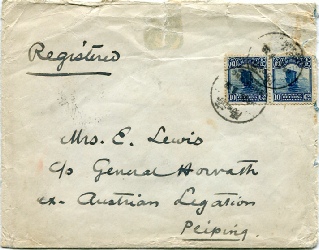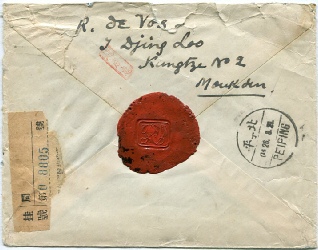
Cliquez sur les images pour agrandir -

LETTRE
Lettre à destination de la Légation autrichienne à Pékin. Postée le 24 juin, elle n’arrivera que le 26 août. Les tensions sont fortes entre la Chine, le Japon et le nouvel État qui n’est pas reconnu. La lettre aurait été bloquée pendant deux mois par la poste chinoise et/ou par les événements…Possible !
Curieux aussi l’affranchissement car il devrait être de 13 cents -
1) Soit les tarifs chinois du 01/02/1929 (1) ont été utilisés par l’expéditeur qui aurait voulu appliquer un double affranchissement pour respecter l’accord postal de 1910.
2) Soit la lettre pesait plus de 20 g et la composition de l’affranchissement aurait été de 5 c pour la lettre (jusqu’à 20 g) + 5 c (de 20 à 40 g) + 8 c de recommandation total 18 cents. Dans ce cas, nous avons 2 cents de sur-
Je pense que la seconde hypothèse est la plus probable même si le sur-
Source :
(1) Catalogue « Tarifs postaux de la République de Chine 1912-
24 juin 1932 -
–
June 24th, 1932 -
|
Dimensions : |
155 x 122 mm |
|
|
Tarif : (République de Chine) |
Lettre intérieure (par 20 g) :…….. 20 g suppléméntaire ?………….. Recommandation……………… Total :……………………………. Sur affranchissement…………… |
5 cents 5 cents 8 cents 18 cents 2 cents |
|
Période de valeur : |
Du 01/02/1929 au 01/05/1932 (1) |
|
|
Timbres utilisés : |
YT (Chine) n°190 (x2) |
|
|
Oblitération : |
N°1.2 Shenyang 24/06/1932 |
|
|
Période d’utilisation : |
Du 22/03/1932 au 06/07/1932 |
|
|
Arrivée : |
Oblitération Pékin le 26/08/1932 |
|
|
Size : |
155 x 122 mm |
|
|
Rate: (Repubic of China) |
Domestic letter (per 20g):……… Added 20 g?……………………. Registration:…………………….. Total:…………………………….. Overpaid……………………….. |
5 cent 5 cent 8 cent 18 cent 2 cent |
|
Period of rate : |
02/01/1929 to 05/01/1932 (1) |
|
|
Stamps : |
SG China n°321 (x2) |
|
|
Postmark : |
N°1.2 Shenyang 06/24/1932 |
|
|
Period of use : |
03/22/1932 to 07/06/1932 |
|
|
Arrival : |
Beijing postmark 08/26/1932 |
|


Letter to the Austrian Legation in Peking. Posted on June 24th, it will arrive only on August 26th. Tensions were high between China, Japan and the new state which was not recognized. The letter would have been blocked for two months by the Chinese post office and/or by the events... Possible!
Curious also the postage because it should be 13 cents -
1) Either the Chinese tariffs of 02/01/1929 (1) were used by the sender who wanted to apply a double franking to respect the postal agreement of 1910.
2) Either the letter weighed more than 20 g and the composition of the postage would have been 5 c for the letter (up to 20 g) + 5 c (from 20 to 40 g) + 8 c of registration total 18 cents. In this case, we have 2 cents of over-
I think that the second hypothesis is the most probable even if the overposting was relatively rare at that time.
Source:
(1) Catalogue "Tarifs postaux de la République de Chine 1912-